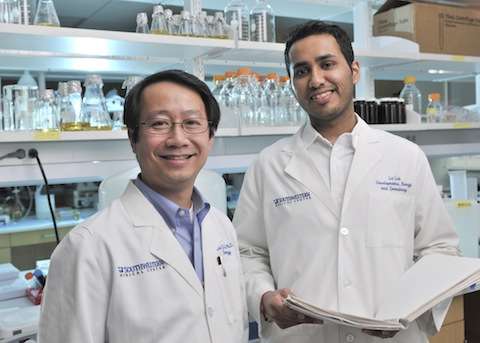Study identifies potential therapeutic target for incurable, rare type of soft-tissue cancer

A deadly, rare type of soft-tissue cancer may be completely eradicated simply by inhibiting a key protein involved in its growth, UT Southwestern Medical Center researchers report.
In the study, published online today in Cell Reports, scientists found that inhibiting the action of a protein called BRD4 caused cancer cells to die in a mouse model of malignant peripheral nerve sheath tumors (MPNSTs).
"This study identifies a potential new therapeutic target to combat MPNST, an incurable type of cancer that is typically fatal," said Dr. Lu Le, Assistant Professor of Dermatology at UT Southwestern and senior author of the study. "The findings also provide important insight into what causes these tumors to develop."
MPNSTs are highly aggressive sarcomas that form around nerves. These tumors can develop sporadically, but about half of cases are in patients with a genetic disorder called neurofibromatosis type 1 (NF1) that affects 1 in 3,500 people. About 10 percent of NF1 patients will develop MPNST, which usually evolves from a benign but often large and disfiguring tumor called a plexiform neurofibroma.
Up to now, the preferred treatment for MPNST has been surgical removal, but that oftentimes is difficult or impossible due to the tumor's location around nerves. Radiation and chemotherapy are other options, but their effectiveness is limited. The five-year survival rate for MPNST patients is about 50 percent.
By studying changes in cells as they evolved into cancerous MPNSTs, researchers in Dr. Le's laboratory were able to determine that BRD4, a bromodomain protein that binds to DNA to regulate gene activation, is expressed at an unusually high level in MPNST cancer cells. This action caused another protein called BCL-2 to keep cancer cells from dying. Alternately, when researchers inhibited BRD4 either genetically in the mice or pharmacologically by administering a compound called JQ1, a promoter of cell death, the tumors shrank.
"These treatments suppressed tumor growth and caused the cancer cells to undergo apoptosis, or cell death. This is why BRD4 inhibition is exquisitely effective against MPNSTs and may represent a paradigm shift in therapy for these patients," Dr. Le said.
The same class of drug used in the experiments is currently being evaluated in phase 1 and 2 trials for treatment of leukemia and a subtype of lung cancer. Meanwhile, UT Southwestern is working with a pharmaceutical company to develop a similar BRD4-inhibiting drug to launch a clinical trial for MPNST patients.
New drugs are desperately needed to treat MPNST and provide hope to NF1 patients at highest risk for this cancer, said Dr. Le, who also serves as Co-director of UT Southwestern's Comprehensive Neurofibromatosis Clinic. The clinic offers neurofibromatosis patients access to the latest clinical trials and treatments. Co-directed by Dr. Laura Klesse, Assistant Professor of Pediatrics, the clinic is part of the Harold C. Simmons Comprehensive Cancer Center and serves patients with all three types of hereditary neurofibromatosis, including the dominant NF1 type and rarer NF2 and Schwannomatosis forms.
















